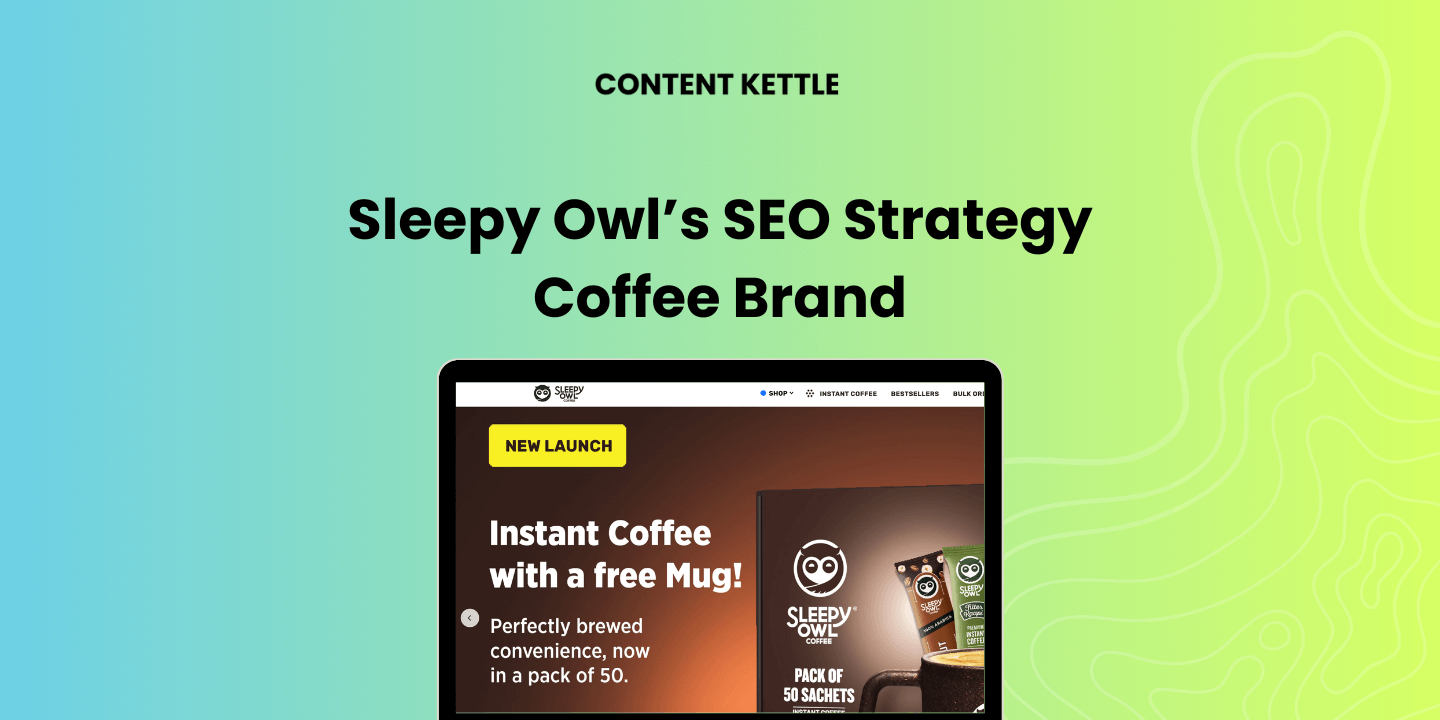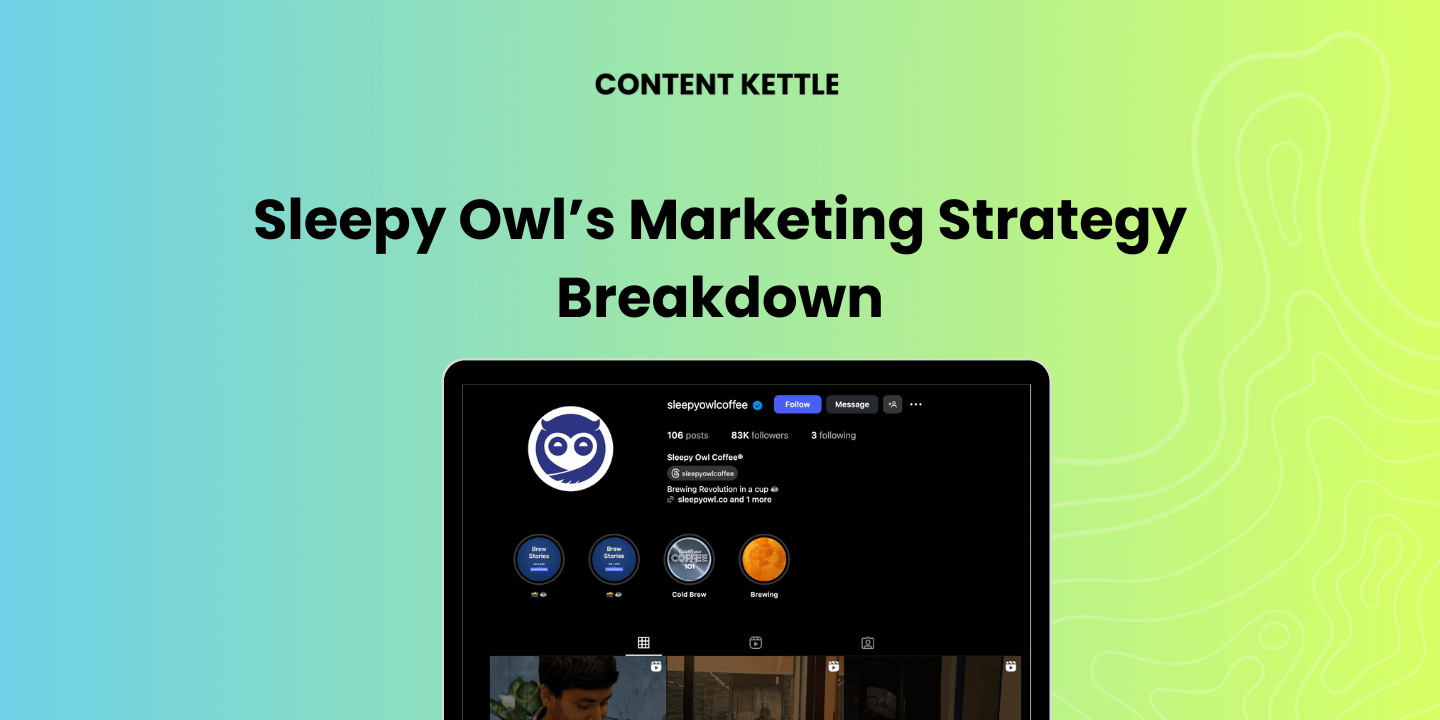The typical eCommerce brand manages to rank for 1,783 keywords organically. That results in roughly 9,625 monthly visitors without spending a dime on ads. If you had to buy that same traffic through paid search, you’d be looking at around $13,453 per month.
Pretty impressive numbers, wouldn’t you say?
But hold on. While the data is real, there’s a serious flaw in it. The fierce competition in eCommerce means the top performers heavily skew these averages; we’re talking about just 5% of brands doing the heavy lifting. For most D2C companies, getting meaningful organic traffic feels like a never-ending chase.
Then there’s Sleepy Owl. They’ve somehow managed to crack the code for one of the most competitive keywords in the history of keywords—“coffee”. Ranking at #2 for such a high-stakes term essentially means they can dial back their marketing spend and still dominate the coffee space.
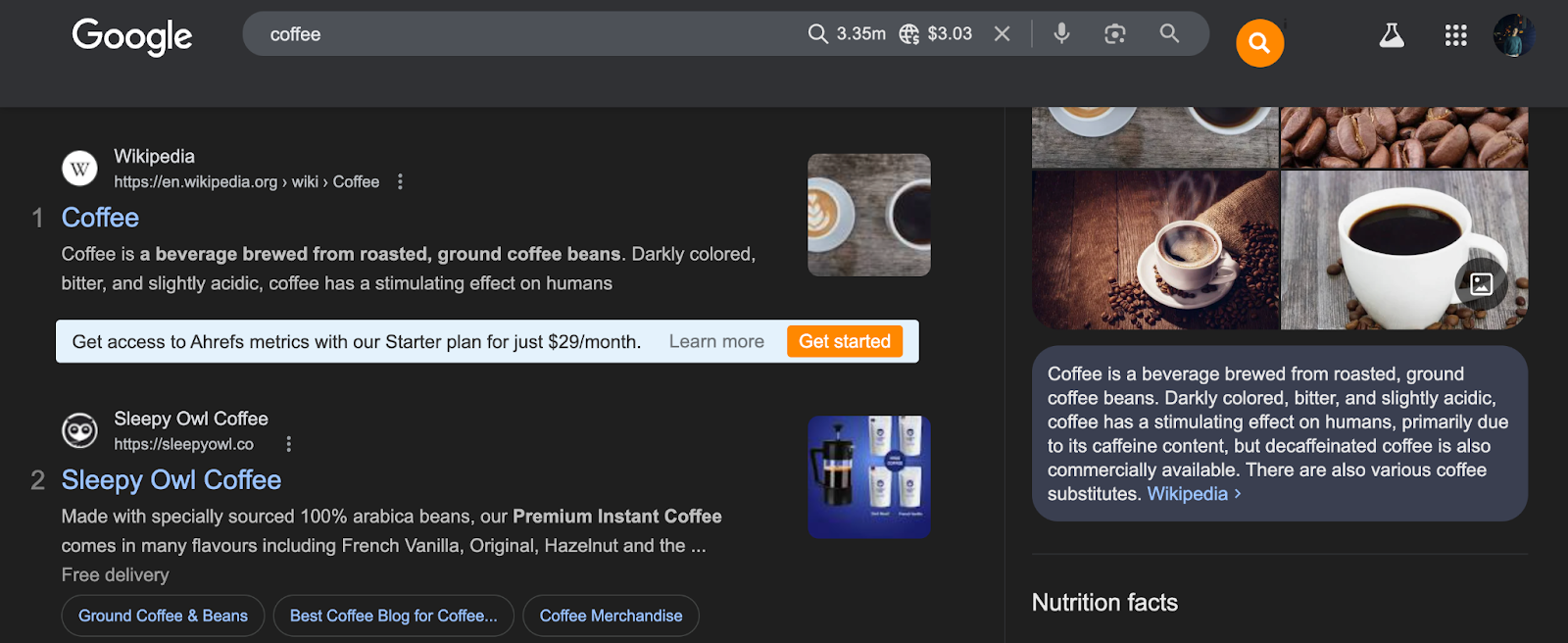
We’re going to show you exactly how they pulled this off. Let’s dive right in!
About Sleepy Owl
Three friends had a simple mission back in 2016: to make great coffee at home way easier than it was. That’s how Sleepy Owl was born. They didn’t just want to sell another coffee brand, they wanted to completely change how Indians think about brewing coffee at home.
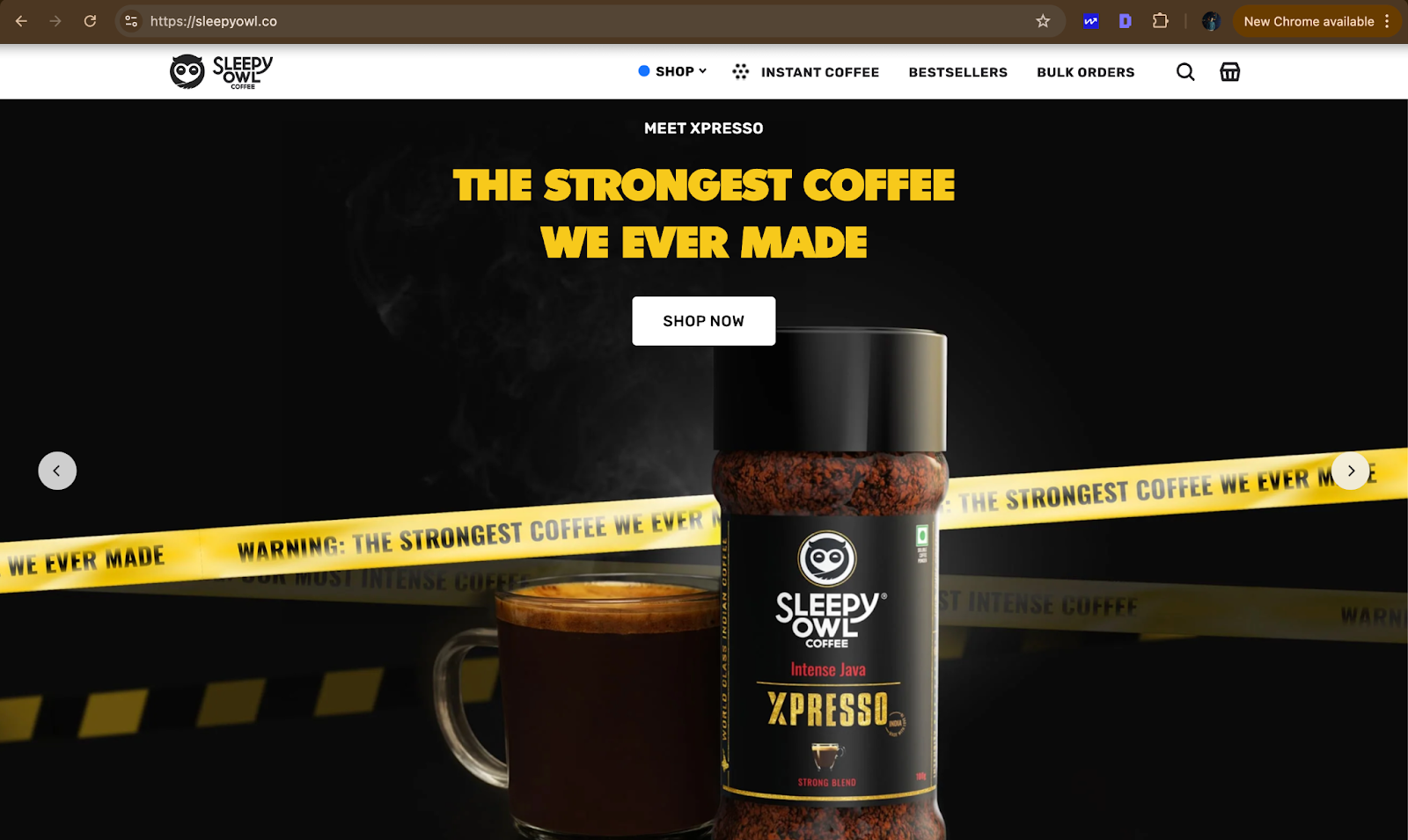
Here’s what made them different from day one. They brought cold brew to India when nobody else was doing it. Think about that for a second. They essentially created a new category in the Indian coffee market. Since then, they’ve expanded their lineup to include premium instant coffee, hot brew bags, ready-to-drink options, South Indian filter coffee, and even some cool merchandise.
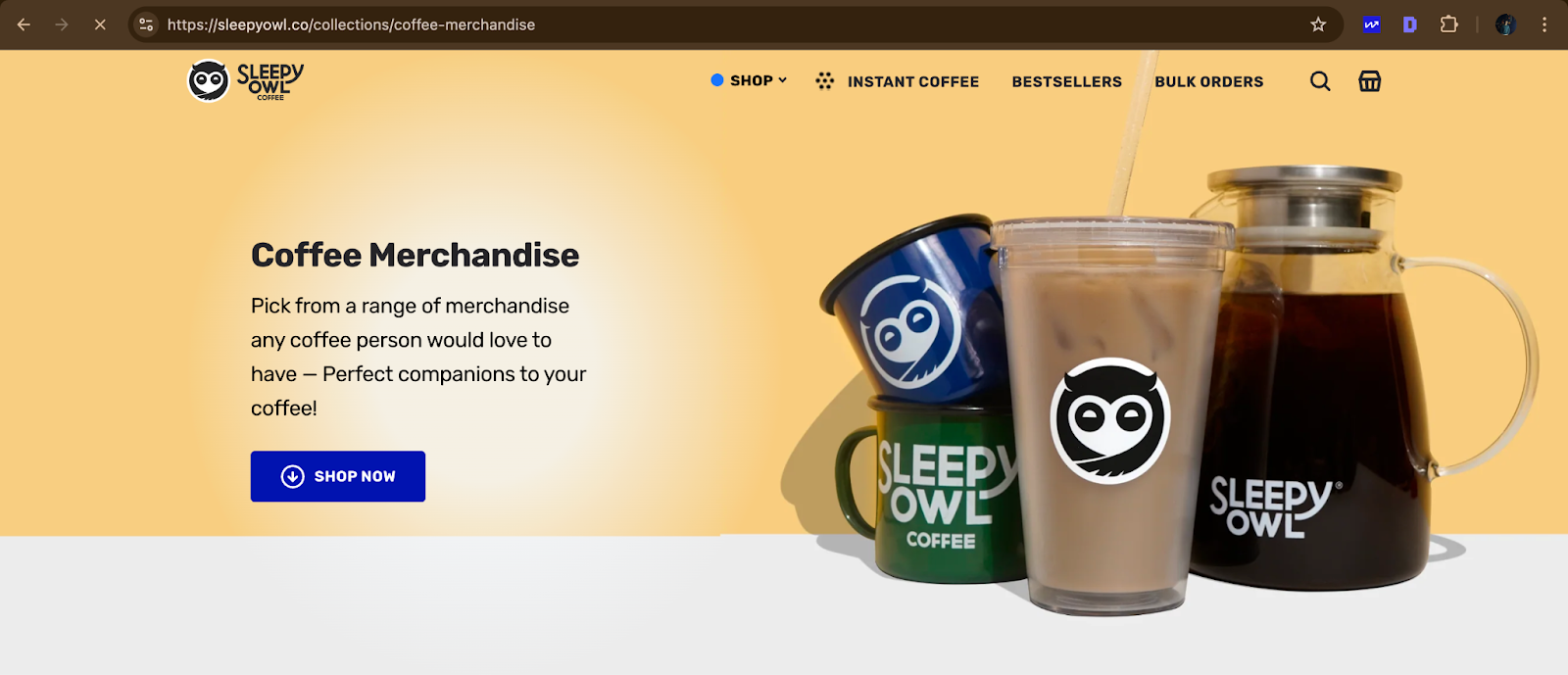
What really sets them apart is their obsession with quality. They source Grade-A beans exclusively from handpicked plantations in South India. No compromises there. Their whole approach is built around making exceptional coffee simple and convenient, which resonates perfectly with young urban professionals who want great taste without the hassle.
Like they say, it’s not what you do, it’s how you do it. Let’s find out then!
Sleepy Owl’s Keyword Strategy: A Three-Pillar Approach
Sleepy Owl doesn’t rank #2 for “coffee” because they’ve written a blog on it. It’s a process that has taken time and a consistent approach towards building topical authority.
They’re ranking for over 4,100 unique keyword phrases across four intent buckets, creating a funnel that starts with “What’s the difference between a latte and a cappuccino?” and ends with someone buying their French-Press kit and coffee options.
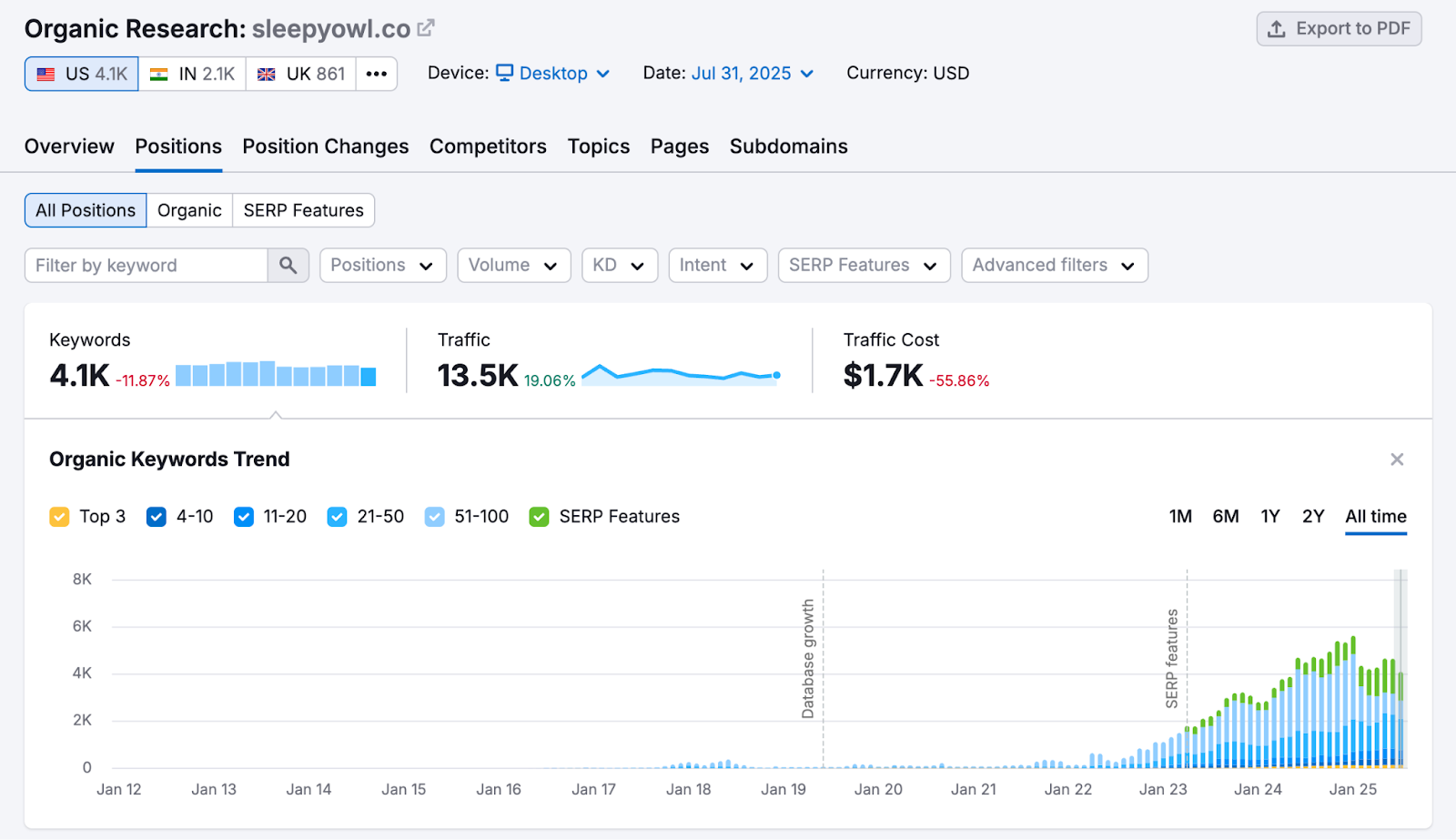
1. Educational content that hooks coffee newbies
This is their secret weapon. Sleepy Owl targets high-volume educational queries like “cappuccino vs latte,” which pulls in over 2,700 monthly searches for them. They’re winning by creating authoritative explainer posts that actually capture featured snippets.

Here’s what’s brilliant about their approach – their “Latte vs. Cappuccino” blog post doesn’t just answer one question. It tackles 14 different keyword variants while weaving in semantic siblings like “caramel latte” and “mocha latte” to satisfy Google’s entity recognition. Then they smoothly introduce their flavored latte kits as the logical next step.
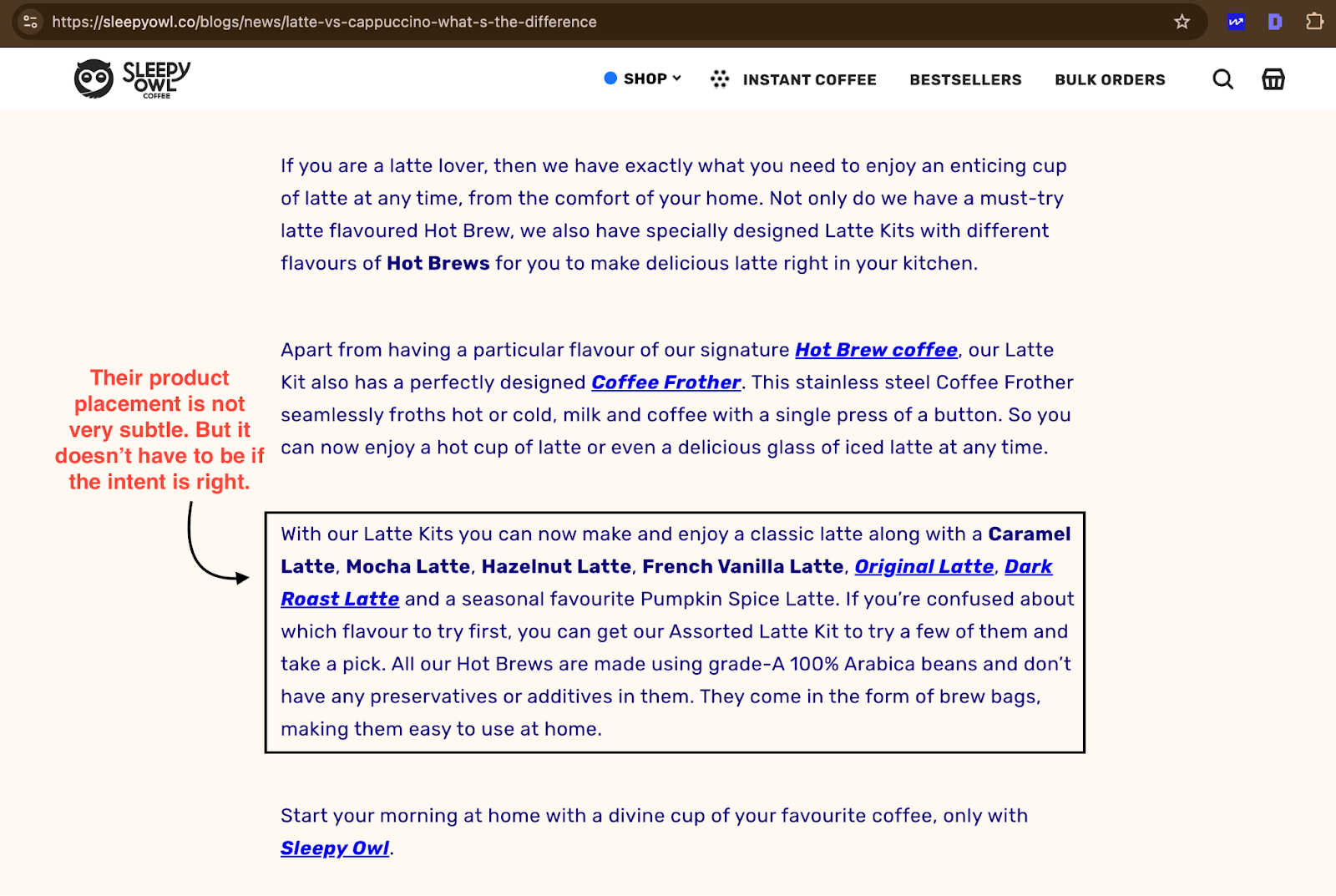
They’ve also cracked the sustainability angle. Posts like “11 ways to put used coffee grounds to good use” capture zero-waste searchers and naturally lead them to Sleepy Owl’s upcycled Ground Coffee Mug. It’s educational content that serves a purpose beyond just traffic.
2. Product-adjacent keywords that drive sales
The middle funnel is where they get tactical. Terms like “coffee frother machine,” “enamel camping mugs,” and “hazelnut cold brew” have lower competition (difficulty under 40) but deliver ready-to-buy traffic. Each product page uses proper schema markup for products, ratings, FAQs, and more, lifting their click-through rates in transactional searches.
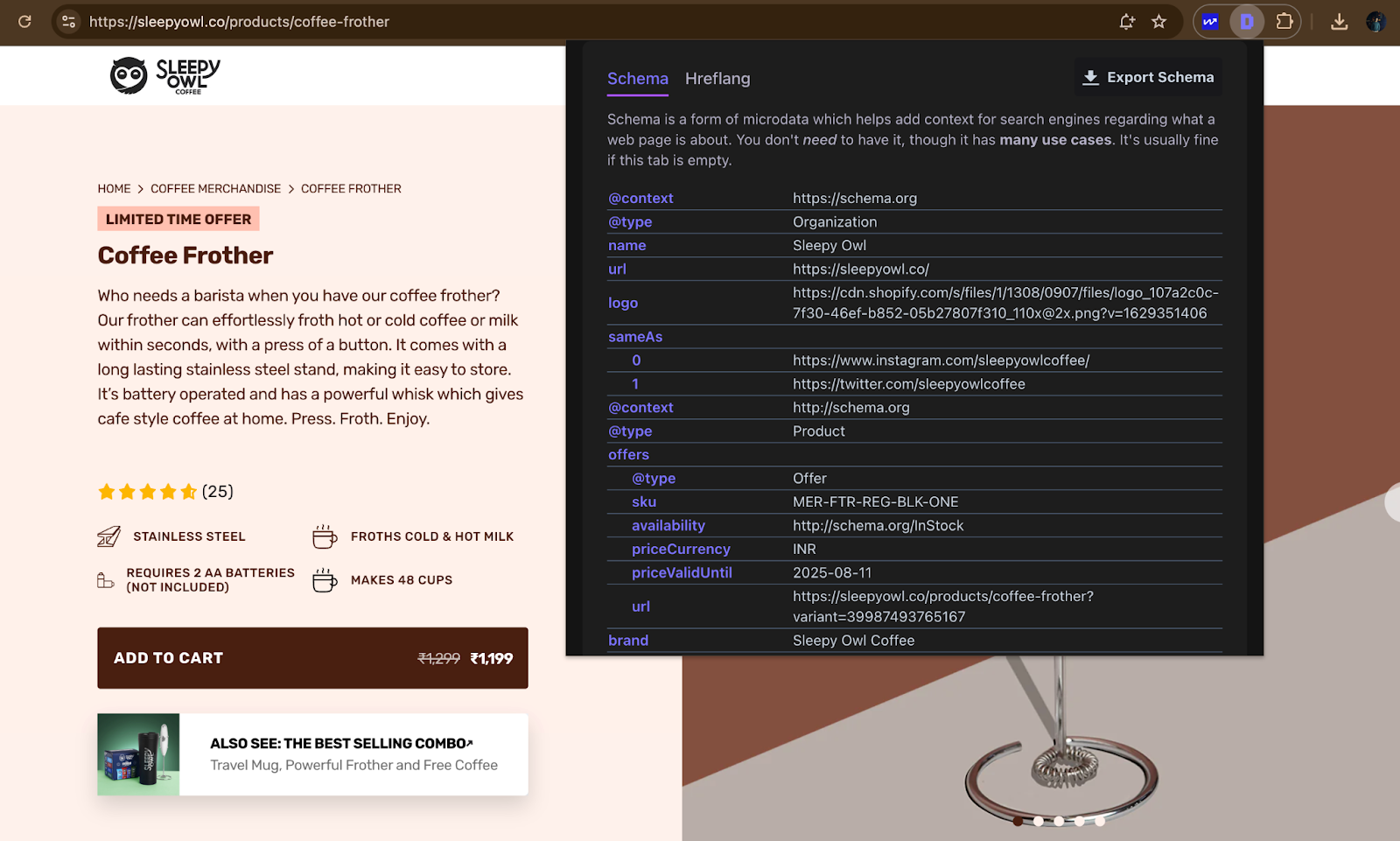
3. Brand defense and lifestyle integration
Branded queries already drive around 30% of their online revenue through D2C channels. They rank sitelinks for sub-collections like Instant, Cold Brew, and Merchandise, which intercepts reseller traffic and protects their margins. Their mascot, “The Owl,” creates social content that references their top-ranking educational snippets, reinforcing keyword alignment across platforms.
4. The Genius of Keyword Cohesion
Sleepy Owl’s keywords aren’t operating in isolation. They’ve created an interconnected web where each ranking keyword supports and amplifies the others. Take their educational content about brewing techniques. When someone lands on “how to make French press coffee,” that article naturally links to their French-press hardware product page, which then connects to their brewing accessories category.
But it goes deeper than internal linking. Their sustainability content about “used coffee grounds uses” doesn’t just capture eco-conscious searchers; it has built backlinks from lifestyle publishers, which strengthens their domain authority (currently at DR 41). This domain boost helps all their keywords rank better across the board.
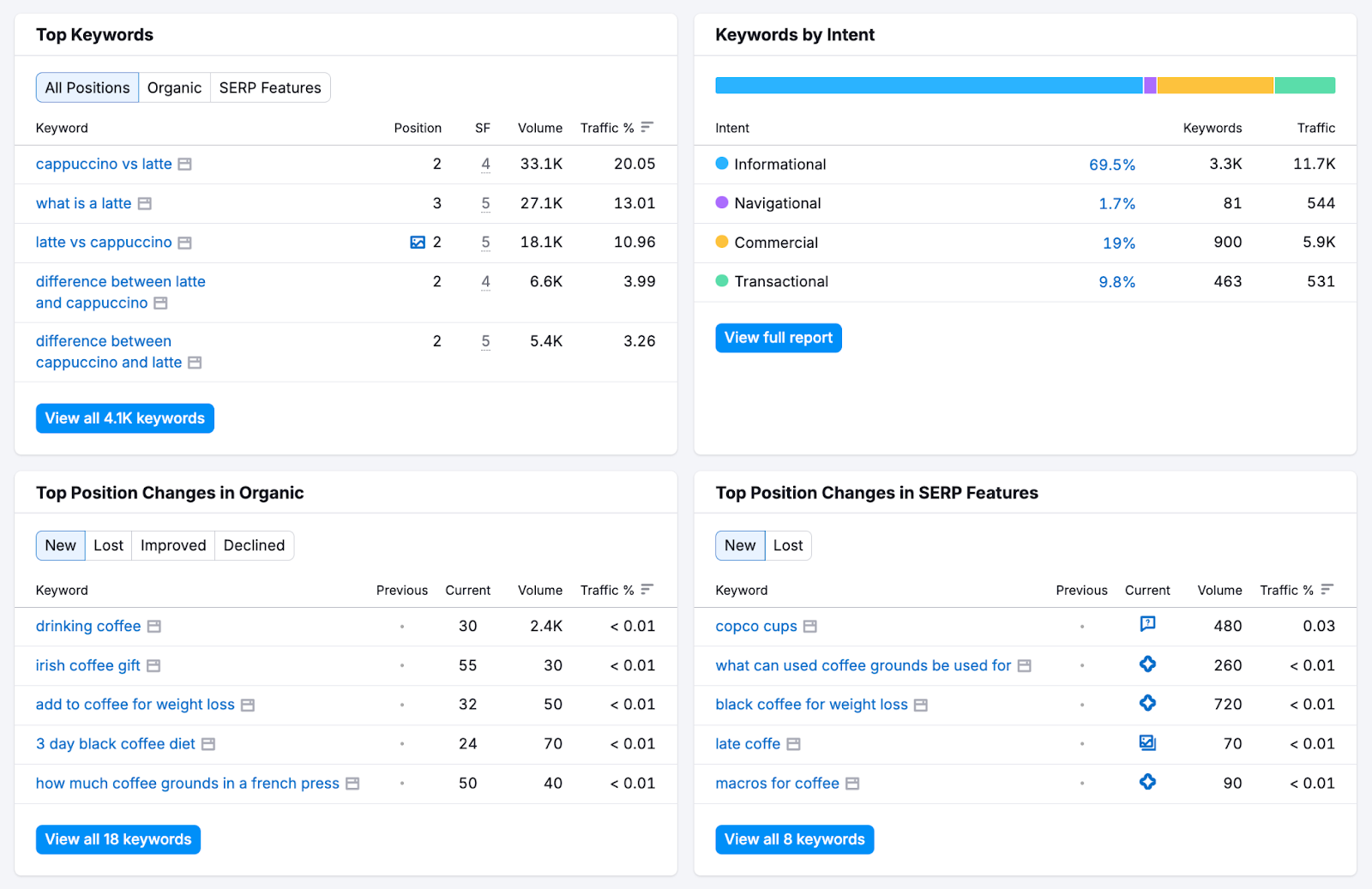
The real magic happens in their content clusters. Their educational content integrates semantic siblings and related terms, which tells Google they’re an authority on coffee education. This topical authority then helps their product pages rank better for commercial terms like “hazelnut cold brew” or “arabica coffee beans.”
Sleepy Owl’s On-Page SEO: The Technical Foundation
We wanted to see if Sleepy Owl’s technical execution matched their keyword strategy brilliance. So we created a custom notebook to scrape and analyze the top 200 pages of their website, examining everything from meta titles to image alt tags. The results were pretty impressive overall.
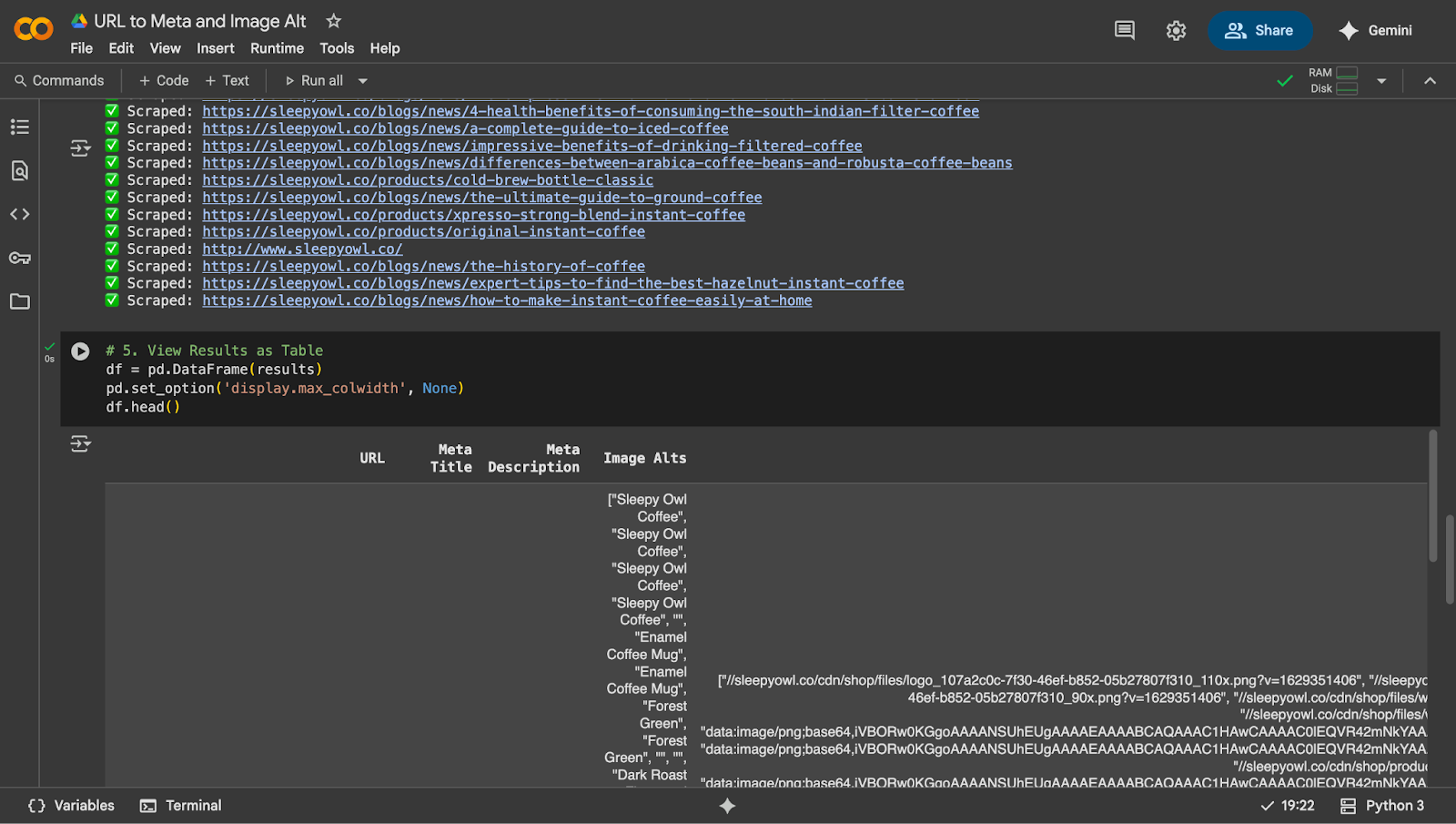
Their meta titles are solid, staying within the optimal 50-60 character range while consistently using a “Product Type | Sleepy Owl” format that balances brand recall with keyword targeting.
Titles like “Buy Instant Coffee Online | Sleepy Owl” clearly target transactional queries, showing they understand search intent.
Meta descriptions hit the sweet spot at 120-155 characters and do a great job highlighting value propositions like “No preservatives” and “100% Arabica.” They’re not just descriptive, they’re sales-focused with clear calls to action like “Shop Now” and “Try It Today.”
Image alt tags show they care about both accessibility and SEO. Product images consistently use descriptive, keyword-rich alt text like “Sleepy Owl Hot Brew Bags” and “Cold Brew Coffee Bottle Sleepy Owl.”
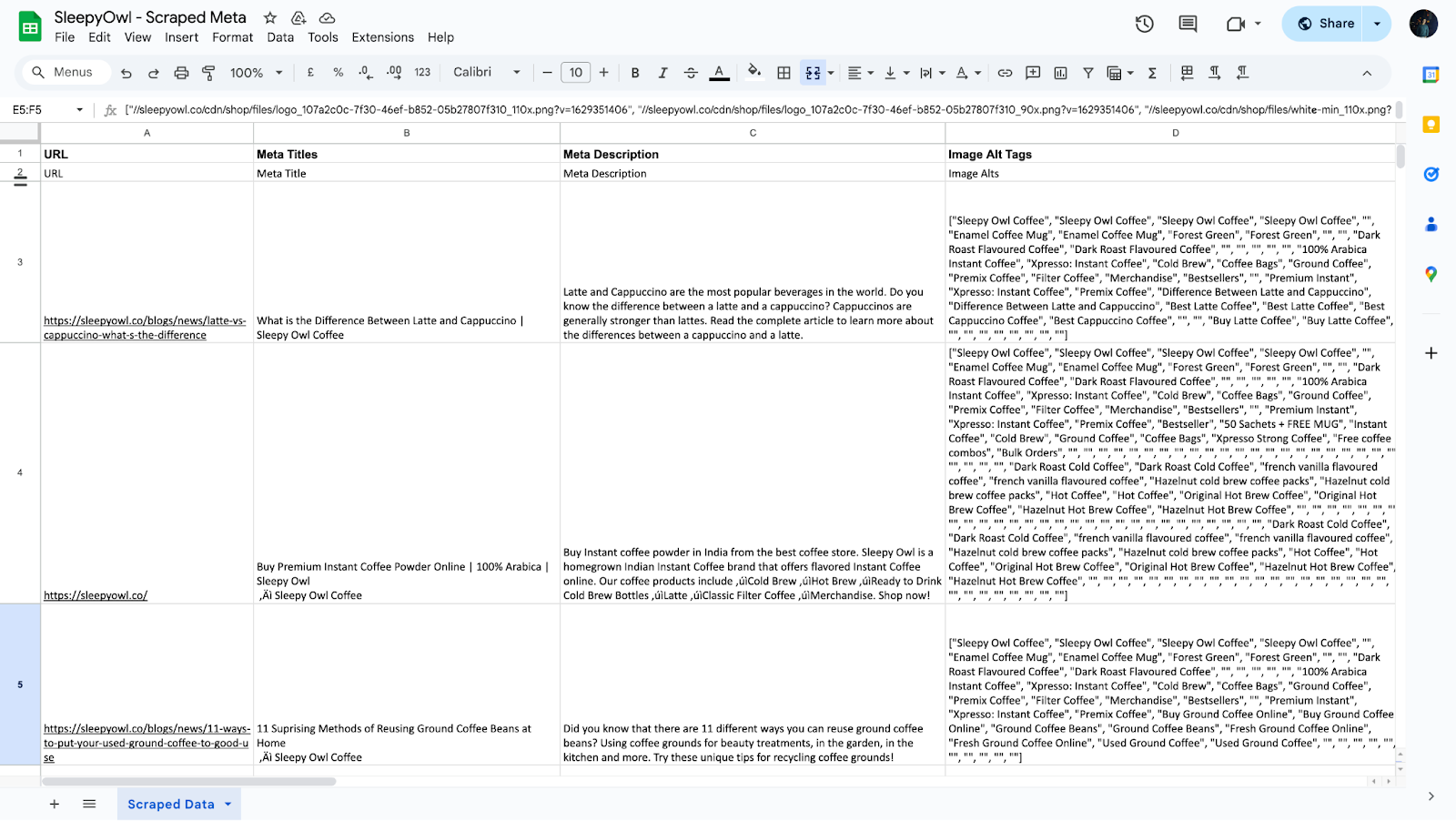
But there’s room for improvement. Some titles are repetitive across different pages, several meta descriptions are duplicated or missing entirely, and some alt tags fall back to generic phrases like “product image.” They’re also missing opportunities to include long-tail keywords and context-rich descriptions for lifestyle images.
Want to analyze your own site’s on-page SEO? You can get free access to our Google Colab Notebook that fetches metadata from any URLs and provides AI-generated recommendations. Just reach out to us on LinkedIn.
Product Categorization: SEO-First Navigation
Here’s where Sleepy Owl shows they really understand search behavior. When you browse their shop, you won’t find clever category names like “Morning Magic” or “Brew Bliss.” Instead, they’ve structured everything around direct keywords that people actually search for.
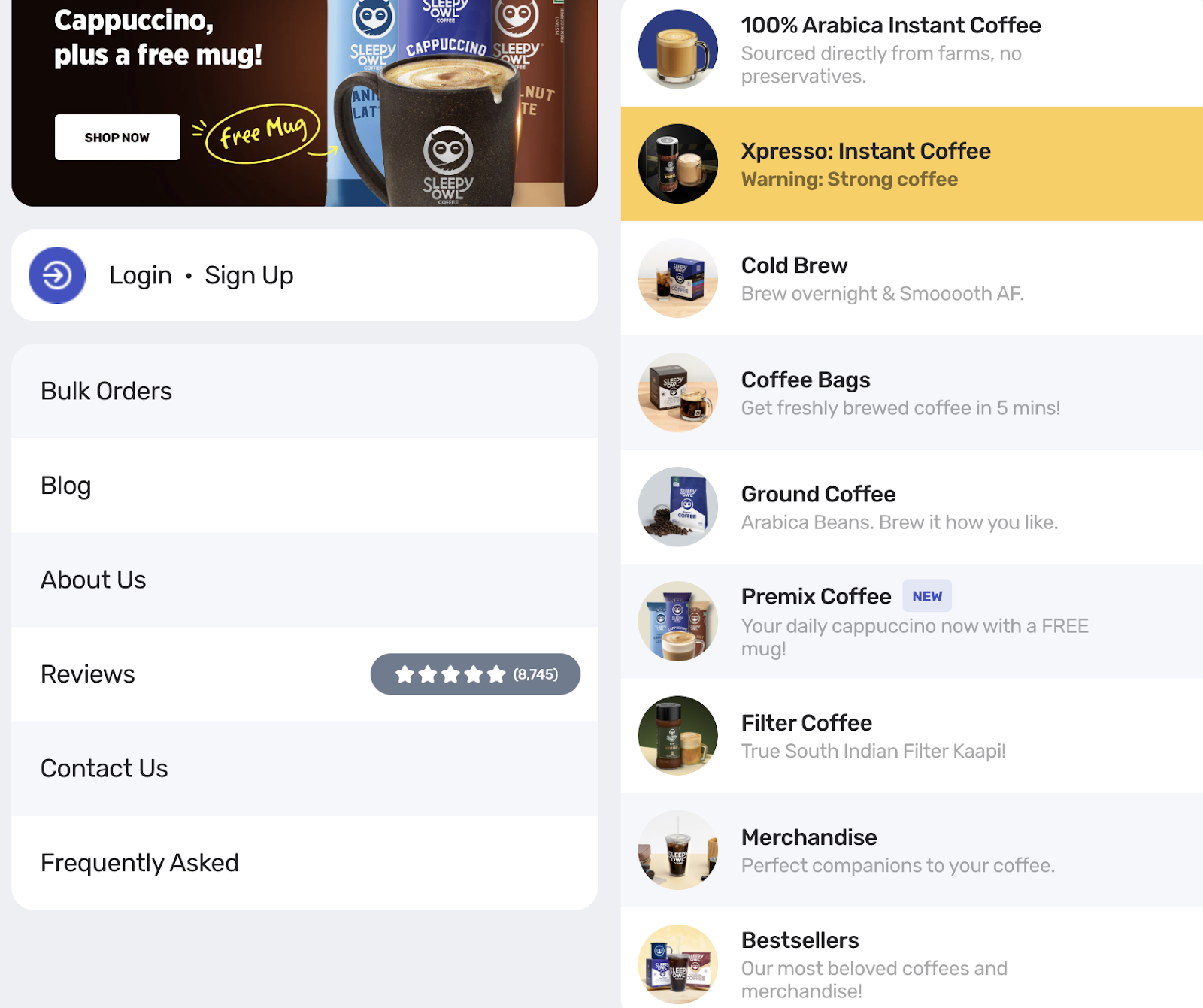
Their main categories are brutally simple: “Instant Coffee,” “Cold Brew,” “Coffee Bags,” “Ground Coffee,” and “Filter Coffee.” No creativity contests here, just pure search intent alignment. When someone types “instant coffee” into Google, they want to land on a page that literally says “Instant Coffee” in the URL and navigation. And no wonder they rank #1 for it.

This extends to subcategories too. Under “Cold Brew,” you’ll find specific flavors like “French Vanilla Cold Brew” and “Hazelnut Cold Brew,” exactly matching how people search for these products. They’ve even optimized product URLs to include primary keywords, so a product page might read “/products/cold-brew-coffee-packs-dark-roast.”
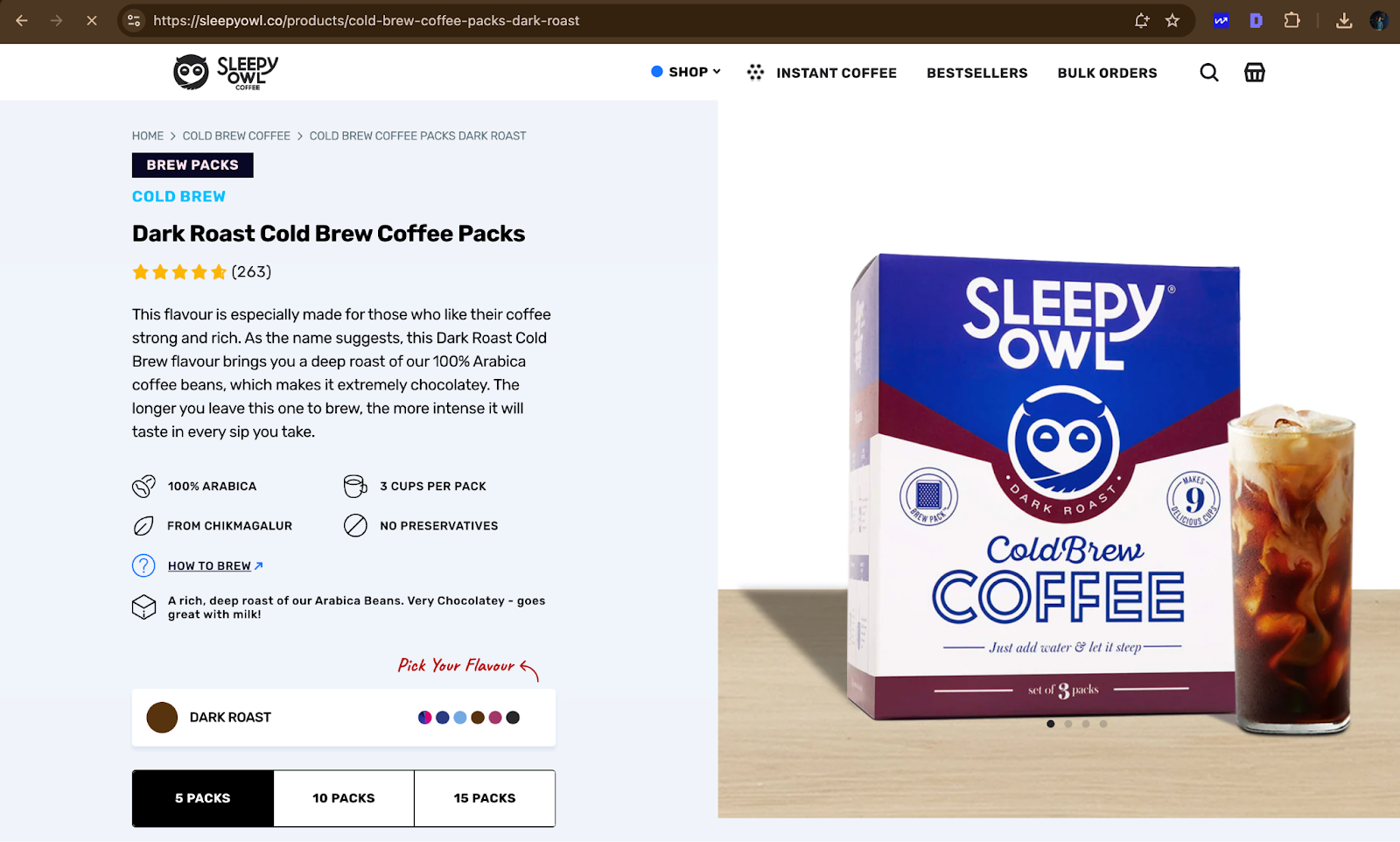
It’s navigation design that prioritizes search engines and user expectations over brand creativity. This results in clean category pages that rank for high-commercial-intent keywords, making it ridiculously easy for customers to find exactly what they’re looking for.
Strategic FAQ Implementation
Every single product page on Sleepy Owl’s site includes a comprehensive FAQ section and this isn’t just for customer convenience. Take their Dark Roast Cold Brew Coffee page as an example. The FAQs tackle common questions like “How is it different from regular coffee?” and “How many cups?” but they’re also strategically targeting long-tail keywords.
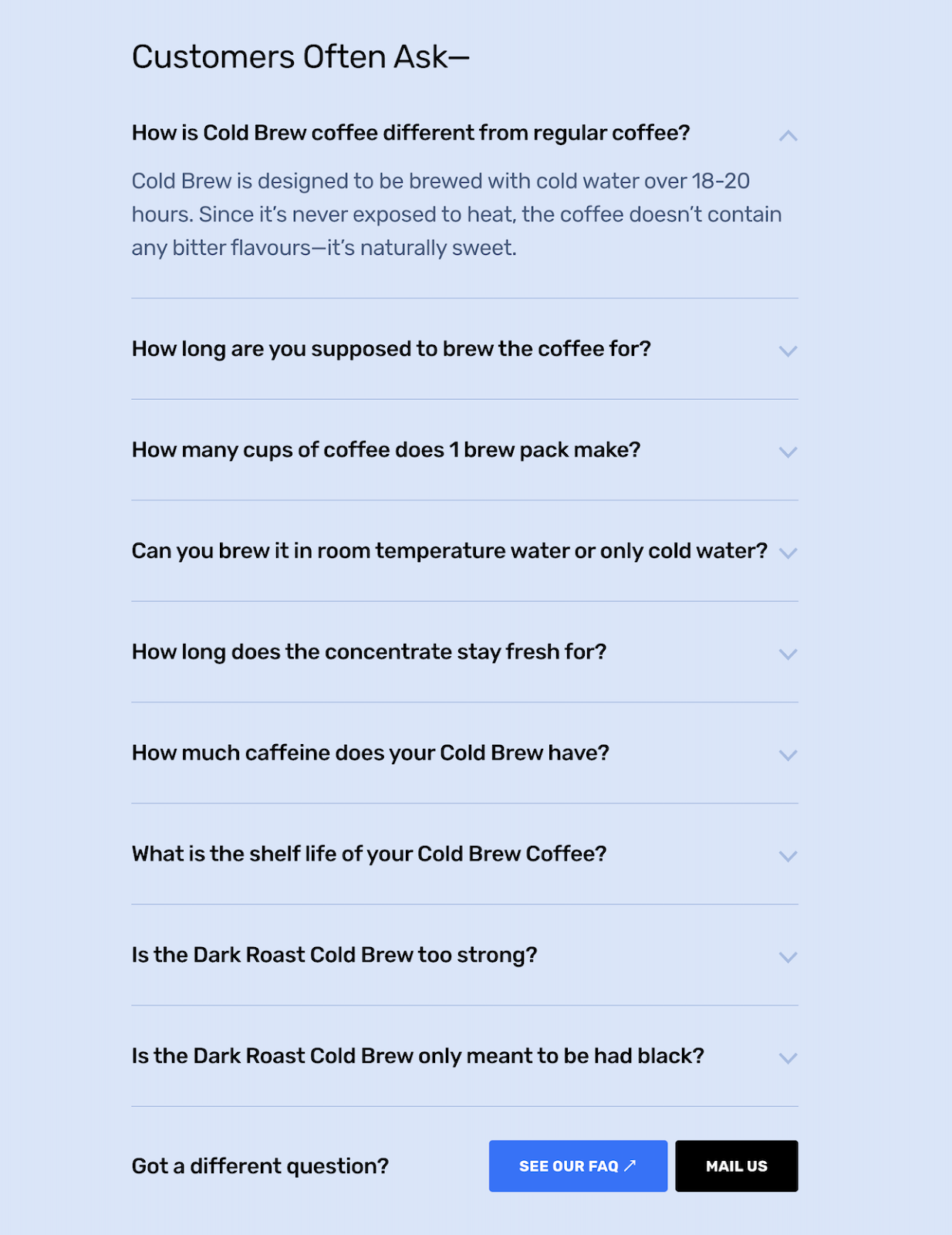
For Sleepy Owl, these FAQ sections serve multiple SEO purposes. First, they add fresh, relevant content to product pages that might otherwise be thin on text. Second, they naturally incorporate conversational search queries that people voice-search or type into Google. Questions like “How do I prepare instant coffee?” match exactly how users search.
The FAQ format also makes pages eligible for Google’s “People Also Ask” boxes and featured snippets. When someone searches “how long does premix coffee last,” Sleepy Owl’s FAQ content can appear directly in search results, driving traffic without requiring a click to their competitors. It’s content that converts visitors while simultaneously boosting organic visibility.
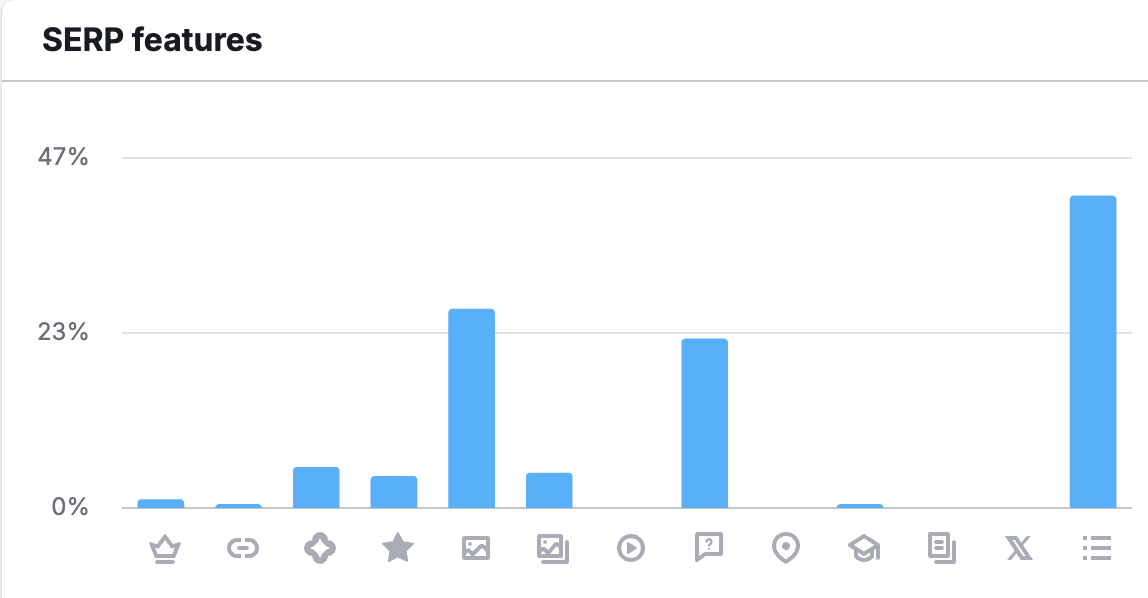
Blog Strategy: Volume Over Trends
Most coffee brands chase trending topics or seasonal content for their blogs. Sleepy Owl takes a completely different approach, they focus on search volume data, not what’s buzzing on social media.

Look at their content calendar and you’ll see they’re not writing about “5 Fall Coffee Trends” or “Celebrity Coffee Habits.” Instead, they’re systematically targeting high-volume, evergreen queries that people search for year-round.
Their blog tackles fundamental questions like “cappuccino vs latte” (which gets massive monthly searches), “what is arabica coffee,” and “uses for coffee grounds.”
This strategy shows up clearly in their keyword targeting. While competitors chase fleeting trends, Sleepy Owl doubles down on queries with consistent search volume – terms like “difference between latte and cappuccino,” “how to make coffee in a french press,” and “hazelnut coffee benefits.” These aren’t glamorous topics, but they deliver predictable, long-term traffic.
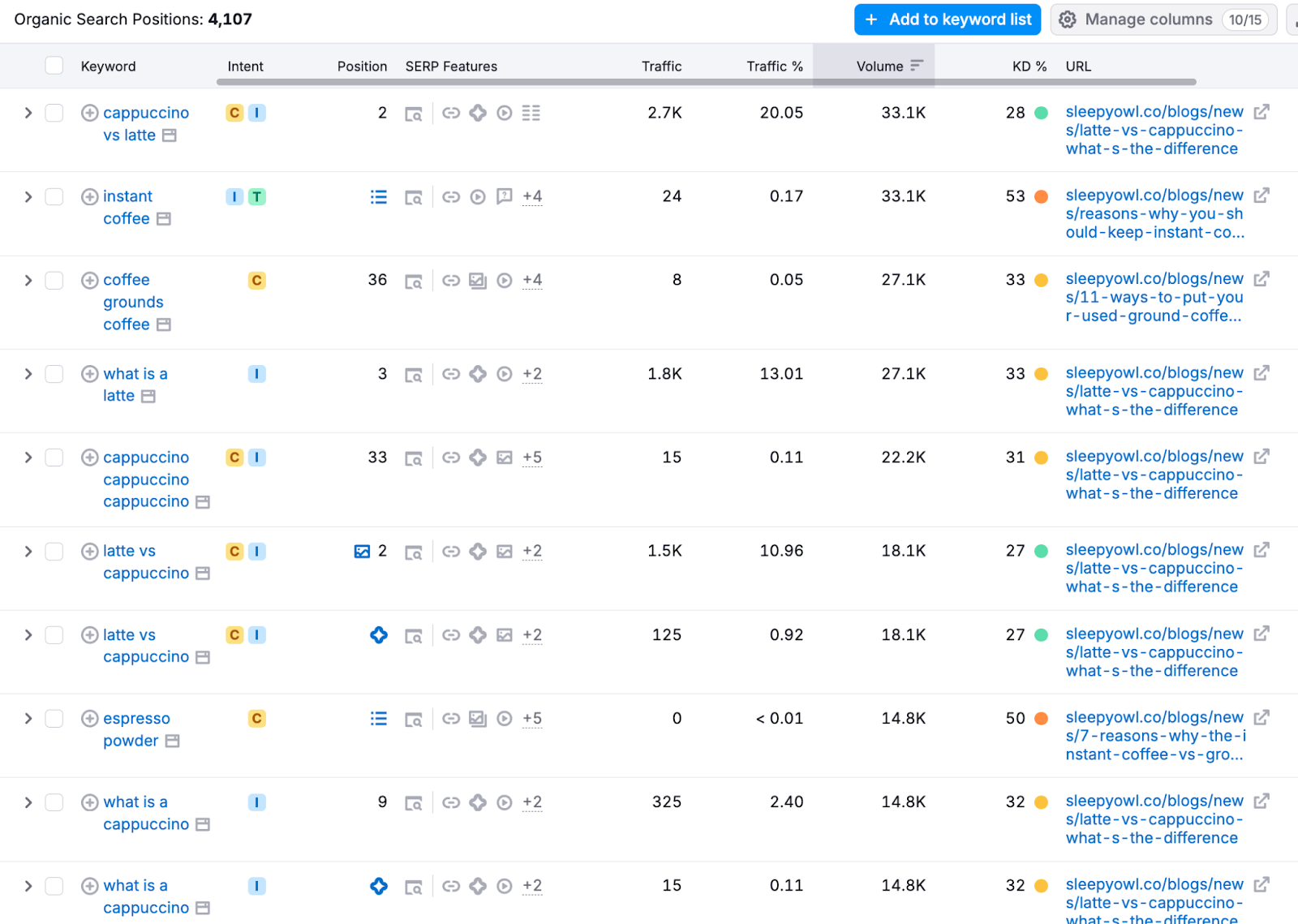
The brilliance is in the execution. Each blog post targets multiple keyword variations of the same core topic. Their latte vs cappuccino article captures searches for “latte and cappuccino difference,” “what’s the difference between a latte and cappuccino,” and dozens of other variations. Its content is built for both search engines and new readers.
Reviews Page: Sleepy Owl’s Conversion Machine
Sleepy Owl’s reviews page might be their most underrated SEO asset. This isn’t a generic testimonials section; it combines user-generated content, social proof, and strategic internal linking.
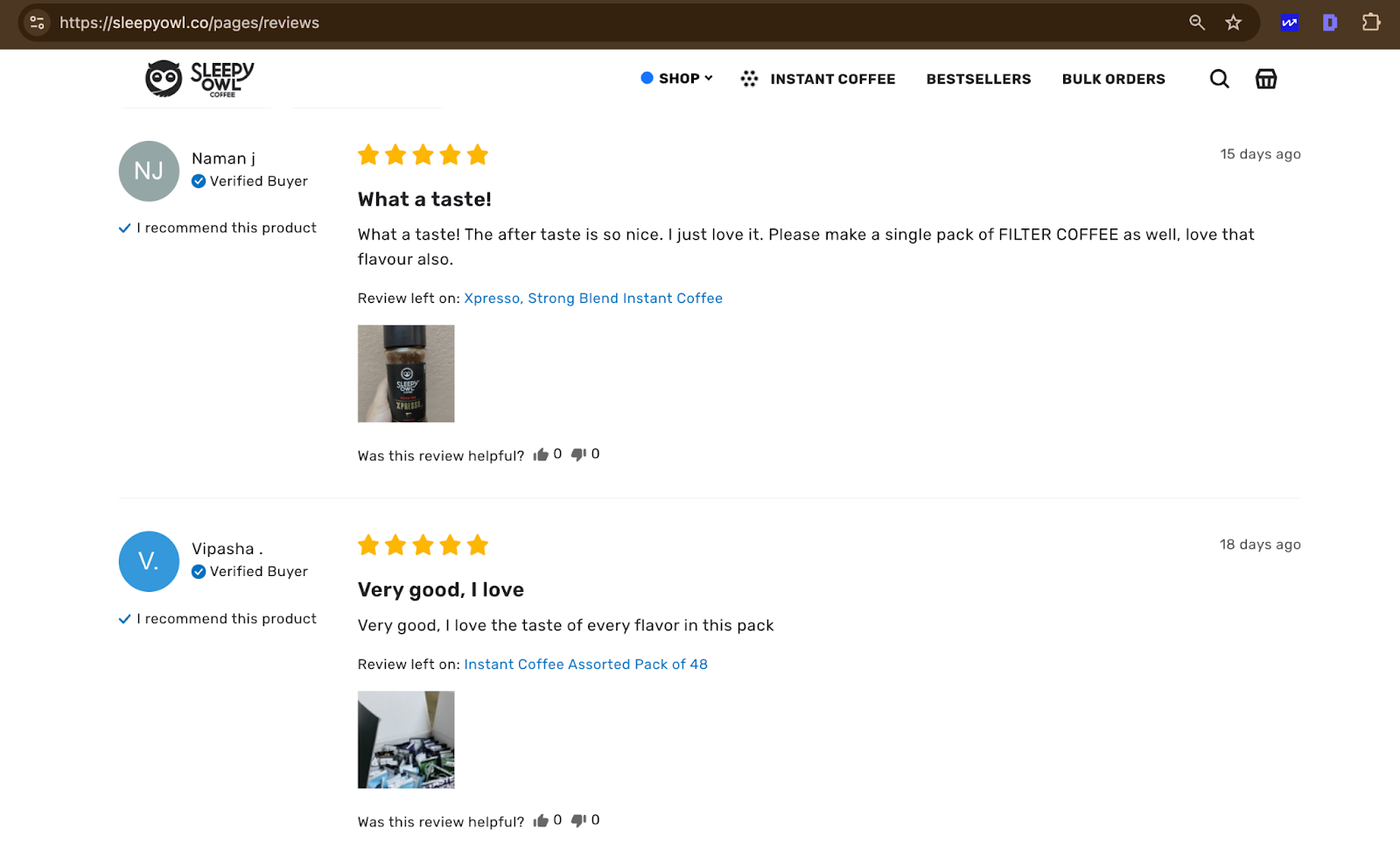
Each review is product-specific and directly links to the mentioned item. When a customer raves about their “Dark Roast Cold Brew,” that review includes a direct link to the product page. This creates natural, contextual internal linking that search engines love while guiding potential customers straight to purchase pages.
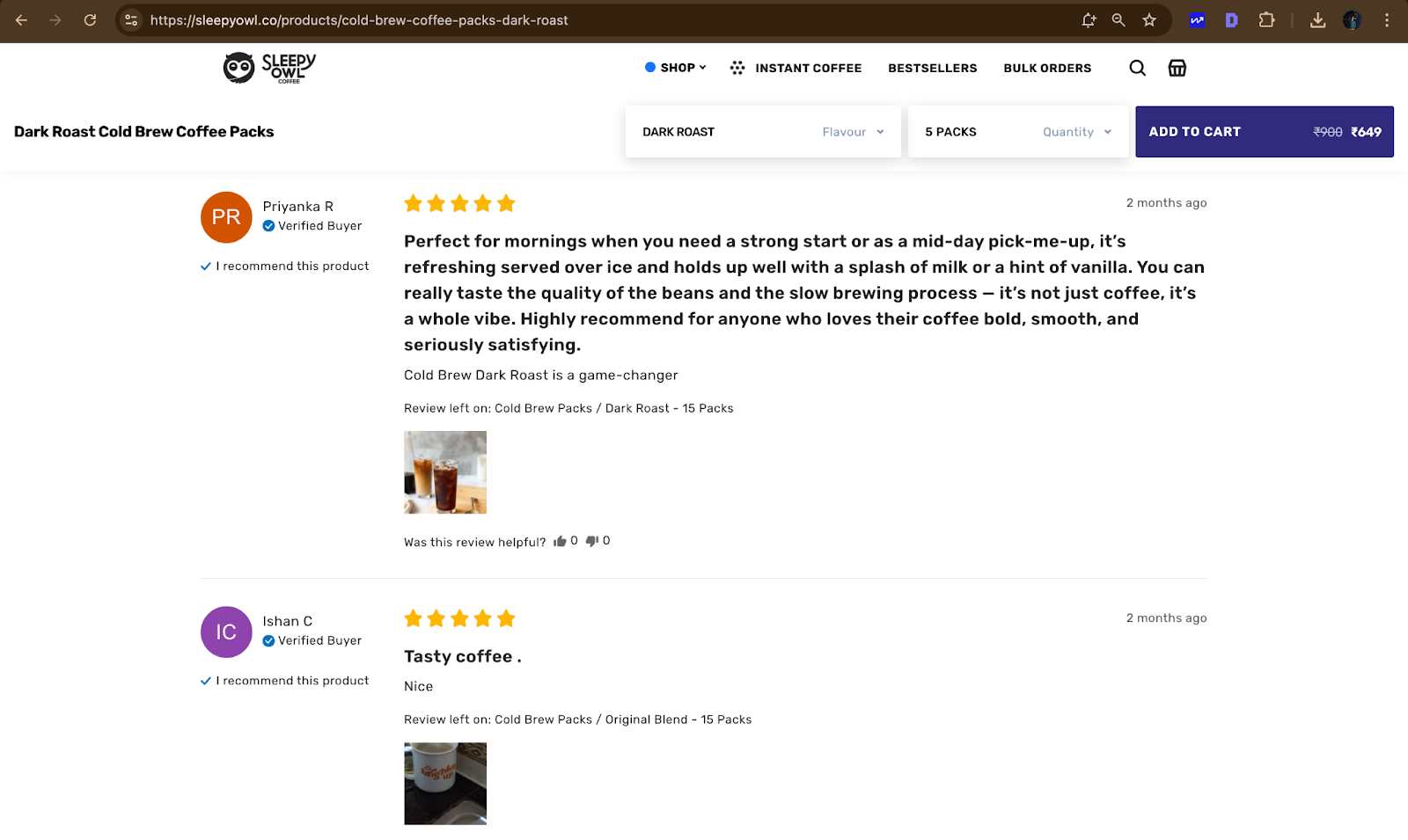
The UGC element is pure gold. Real customer reviews using natural language like “best instant coffee for travel” or “perfect cold brew for summer” automatically incorporate long-tail keywords that Sleepy Owl might never have thought to target themselves.
The reviews page itself becomes a ranking asset. It’s loaded with product-related keywords, customer testimonials, and fresh content that gets updated organically as new reviews come in. It’s social proof that doubles as SEO fuel.
Sleepy Owl’s Sitemap: Clean Architecture for Crawlers
Sleepy Owl’s sitemap is refreshingly organized – no bloated mess here. They’ve streamlined everything into clear sections: Collections, Products, Blog Posts, and Pages. Each category is properly separated, making it easy for search engine crawlers to understand their site structure.
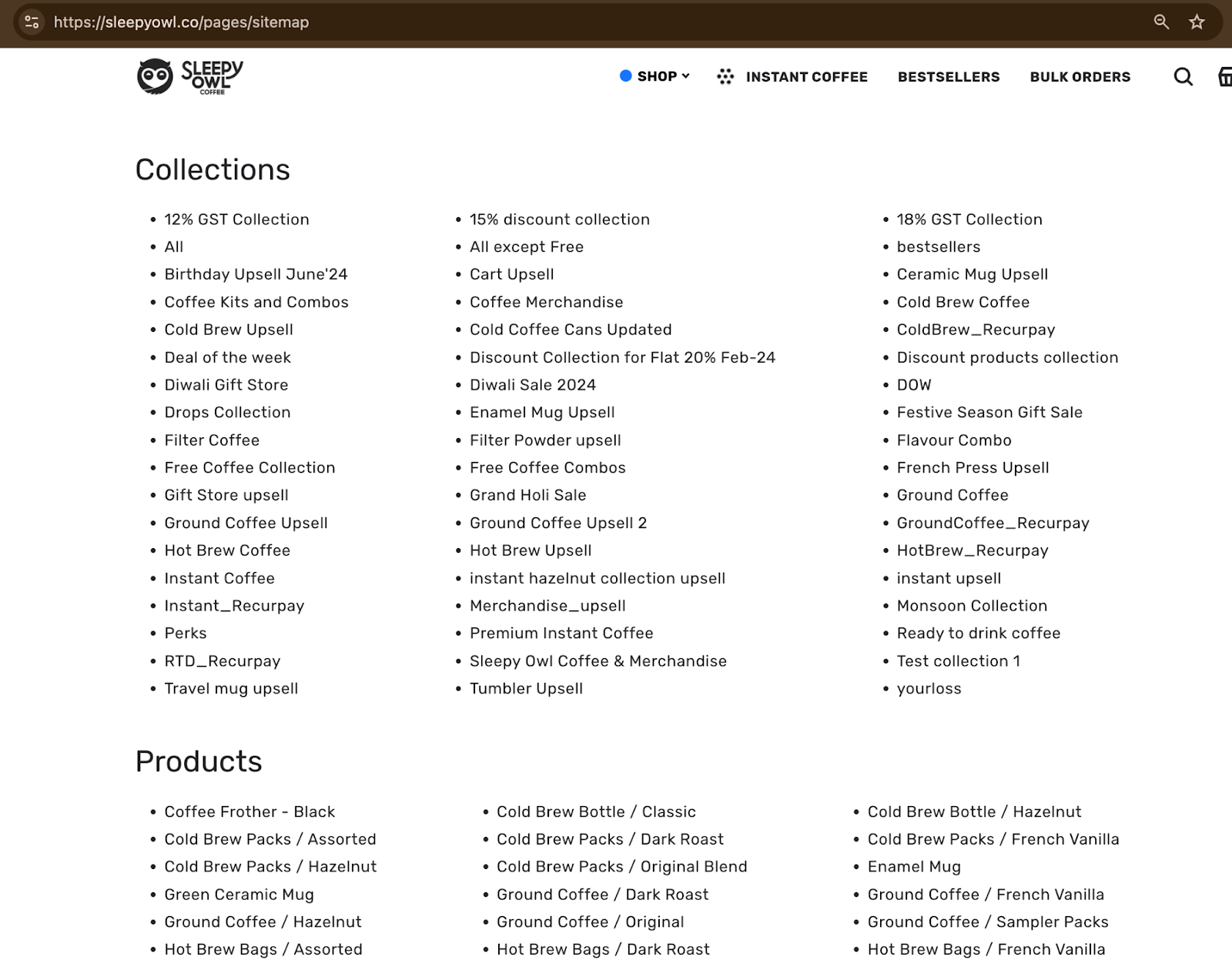
The collections section groups products logically (Instant Coffee, Cold Brew, Free Coffee Collection), while individual product pages are cleanly listed with SEO-friendly URLs. Blog posts are chronologically organized, and static pages like Reviews and About Us get their own dedicated section.
Product Videos: Engagement That Ranks
Sleepy Owl embeds product videos directly on their pages, and it’s paying off in multiple ways. These are strategic engagement boosters that keep visitors on-site longer, reducing bounce rates and sending positive user experience signals to Google.
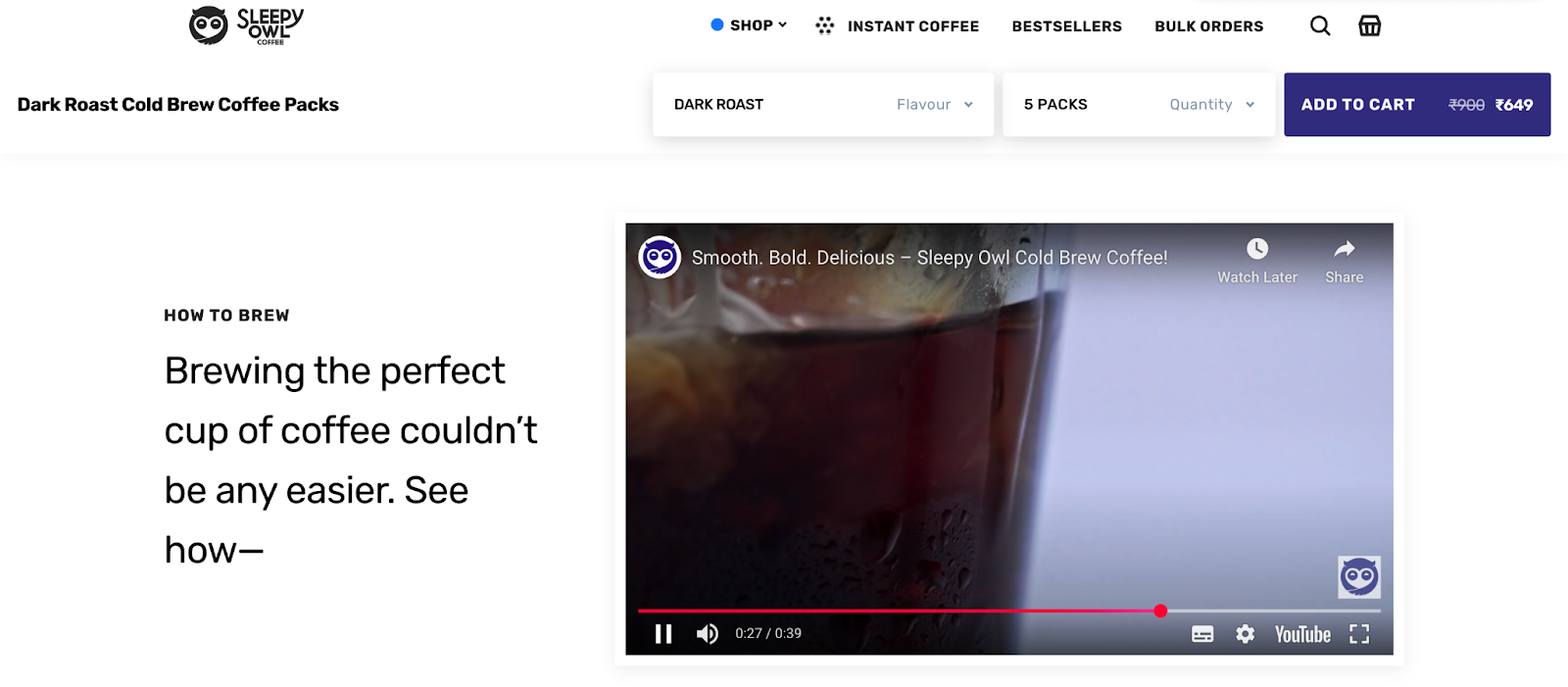
When someone watches a 30-second brewing demonstration, they’re spending meaningful time on the page. This extended dwell time tells search engines the content is valuable and relevant. Plus, videos naturally encourage social sharing and can appear in video search results, creating additional discovery opportunities beyond traditional organic listings.
Conclusion
SEO is tricky for DTC and eCommerce brands, most struggle to get it right. From tactical to technical errors, even great brands like Sleepy Owl leave some value on the table. But with the right strategy, SEO can drive real growth like how it’s doing for Sleepy Owl.
Want to optimize your on-page SEO and boost organic sales? Contact us, we’ll help you get there!
